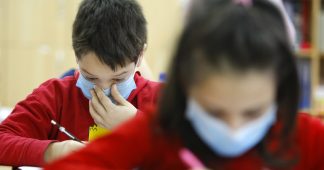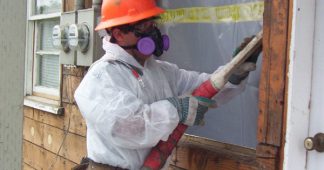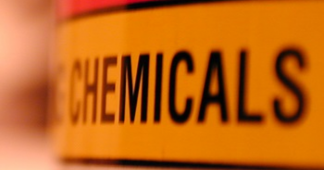A Danish study found that people with elevated levels of a compound called PFBA were more than twice as likely to have a severe form of Covid-19.
By Sharon Lerner
Elevated levels of a PFAS compound were associated with more severe forms of Covid-19, according to a Danish study now undergoing peer review. The research, which involved 323 patients infected with the coronavirus, found that those who had elevated levels of a chemical called PFBA were more than twice as likely to have a severe form of the disease.
PFBA is one of a class of industrial compounds, often called “forever chemicals,” that has come to contaminate soil, water, and food around the world. It has been presented as relatively safe because it stays in human blood for much less time than some of the other compounds in the class and is a shorter molecule. Both traits are thought to be indications of its innocuousness. PFBA, which was created by 3M, is based on a four-carbon chain and is gone from human blood in a matter of days. It is still in use, while PFOA, which is based on eight carbons and stays in the human blood for years, has been phased out since 2015.
Though PFBA exits the bloodstream relatively rapidly, it accumulates in the lungs, which likely explains the finding of the Danish study. “It’s probably what’s in the lungs that counts because that’s where the big Covid battle is fought,” said Philippe Grandjean, the principal author of the study. Grandjean’s study involved 323 patients with Covid-19, 215 of whom were hospitalized. The researchers analyzed the blood of these patients for the presence of five PFAS compounds and found that only perfluorobutanoic acid, or PFBA, was associated with the severity of the disease. More than half of those seriously ill with Covid-19 had elevated PFBA levels in their plasma, while less than 20 percent of those with mild illness had elevated levels of the chemical.
The Centers for Disease Control and Prevention does not include PFBA in its surveillance of the blood levels of various PFAS compounds. But it is clear that the chemical is both widespread and particularly elevated in certain areas. Research conducted by 3M in 2005 showed that 20 of 36 pooled blood samples from the general population contained PFBA. More recent research from the Minnesota Department of Health shows that levels of the compound are elevated in the East Metro area near a 3M plant in the suburbs of Minneapolis–St. Paul. The chemical has also been found in other parts of the world, including Vietnam, Jordan, Thailand, and Japan. PFBA was also found in the Tennessee River near a 3M plant in Decatur, Alabama, and near a 3M plant in Cordova, Illinois. And it has been found in food, including radish, peas, tomatoes, and lettuce.
PFBA is used in electronics; clothing, including water-resistent outerwear; protective gear for medical staff and firefighters, such as surgical gowns; firefighting foam; carpets; floor polish; laboratory equipment; leather treatment; food packaging; cosmetics, including body lotion and foundation, concealer, eye shadow, powder; and bike lubricants, according to a recently published paper on the previously unknown uses of the chemicals.
According to the Minnesota Department of Health, which has set a safety limit for the chemical, PFBA causes changes in the liver and thyroid, as well as decreased red blood cells, decreased cholesterol, and delayed eye opening in animal experiments. A division of the Environmental Protection Agency called the Integrated Risk Information System, or IRIS, is in the process of assessing the dangers of PFBA and is scheduled to release its report in the first quarter of the coming year. Asked for comment, 3M referred The Intercept to a statement on its website asserting that “the available scientific evidence does not support a causal relationship between PFAS exposures and COVID-19 health outcomes.”
Grandjean’s previous research has shown that higher PFAS levels in children correlated to weaker response to various vaccines — and he fears the same will be true for a Covid-19 vaccine.
“I would think what we’ve seen before is very likely to happen again,” he said about the vaccines now in development for Covid-19. Communities that have elevated levels due to industrial contamination should get special consideration when a vaccine is distributed, he said. “They may need more than the 1 or 2 shots recommended for everyone else because their antibody production may be suppressed.”
Update: December 7, 2020
This article has been updated with a response from 3M that was received after publication.
Published at theintercept.com











